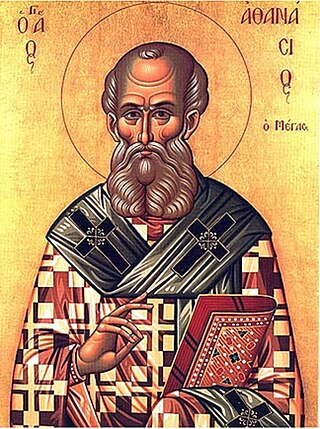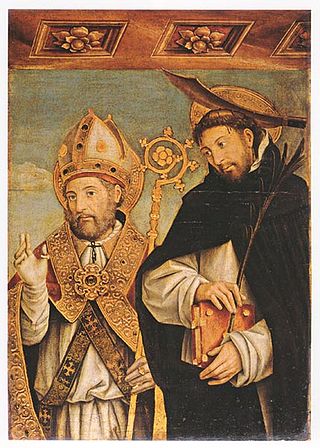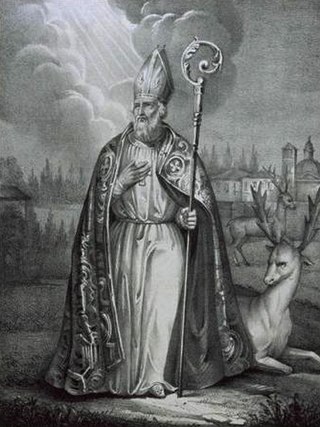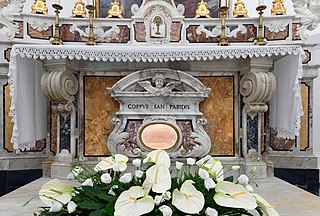Related Research Articles

Athanasius I of Alexandria, also called Athanasius the Great, Athanasius the Confessor, or, among Coptic Christians, Athanasius the Apostolic, was a Christian theologian and the 20th pope of Alexandria. His intermittent episcopacy spanned 45 years, of which over 17 encompassed five exiles, when he was replaced on the order of four different Roman emperors. Athanasius was a Church Father, the chief proponent of Trinitarianism against Arianism, and a noted Egyptian Christian leader of the fourth century.

Pope Julius I was the bishop of Rome from 6 February 337 to his death on 12 April 352. He is notable for asserting the authority of the pope over the Arian Eastern bishops, as well as setting December 25 as the official birthdate of Jesus.
The 350s decade ran from January 1, 350, to December 31, 359.
Year 356 (CCCLVI) was a leap year starting on Monday of the Julian calendar. At the time, it was known as the Year of the Consulship of Constantius and Iulianus. The denomination 356 for this year has been used since the early medieval period, when the Anno Domini calendar era became the prevalent method in Europe for naming years.
Pope John I was the bishop of Rome from 13 August 523 to his death. He was a native of Siena, in Italy. He was sent on a diplomatic mission to Constantinople by the Ostrogoth King Theoderic to negotiate better treatment for Arians. Although John was relatively successful, upon his return to Ravenna, Theoderic had him imprisoned for allegedly conspiring with Constantinople. The frail pope died of neglect and ill-treatment.

Hilary of Poitiers was Bishop of Poitiers and a Doctor of the Church. He was sometimes referred to as the "Hammer of the Arians" and the "Athanasius of the West". His name comes from the Latin word for happy or cheerful. In addition to his important work as bishop, Hilary was married and the father of Abra of Poitiers, a nun and saint who became known for her charity.

Paul I or Paulus I or Saint Paul the Confessor, was the sixth bishop of Constantinople, elected first in 337 AD. Paul became involved in the Arian controversy which drew in the Emperor of the West, Constans, and his counterpart in the East, his brother Constantius II. Paul was installed and deposed three times from the See of Constantinople between 337 and 351. He was murdered by strangulation during his third and final exile in Cappadocia. His feast day is on November 6.

Frumentius was a Phoenician Christian missionary and the first bishop of Axum who brought Christianity to the Kingdom of Aksum. He is sometimes known by other names, such as Abuna and Aba Salama.

Eusebius of Vercelli was a bishop from Sardinia and is counted a saint. Along with Athanasius, he affirmed the divinity of Jesus against Arianism.
Bertulf was the third abbot of the monastery of Bobbio.

Saint Liberalis of Treviso is a saint of the 4th century. Tradition states that he was a priest who opposed Arianism and that he was persecuted at Ancona.

Evasius is believed to have been a missionary and bishop of Asti, in north-west Italy. He was forced to flee to the great Padan forest known as the Selva Cornea, where he and numerous followers were beheaded by pagan, or alternatively by Arian enemies, in the area of what is now Casale Monferrato. He is venerated as a saint of the Roman Catholic Church and is the patron of a number of towns in Piedmont and Lombardy. His cult is liveliest at Casale, where his remains are conserved in the cathedral dedicated to him.

Bassianus of Lodi was an Italian saint, the patron saint of Lodi and Pizzighettone in Italy.

The diocese of Teano-Calvi is a Latin diocese of the Catholic Church in Campania, southern Italy, created in 1986. It is a suffragan of the Archdiocese of Naples. The historic Diocese of Teano and diocese of Calvi Risorta were united in 1818, forming the diocese of Calvi e Teano.
The Diocese of Teano was a Roman Catholic diocese in Italy, located in the city of Teano in the province of Caserta in Campania, Italy. In 1818, it was united the Diocese of Calvi Risorta to form the Diocese of Calvi e Teano. In 1986, the two dioceses were combined into one, with the seat of the bishop at Teano.

Heliodorus was the first bishop of Altinum in the 4th century. He was born in Dalmatia. Like Chromatius, he was a disciple of Valerianus, the bishop of Aquileia.

Constantine the Great's (272–337) relationship with the four Bishops of Rome during his reign is an important component of the history of the Papacy, and more generally the history of the Catholic Church.

Saint Paris or Paris of Teano was ordained Bishop of Teano by Pope Sylvester I. His feast day is August 5.

December 6 - Eastern Orthodox liturgical calendar - December 8

Giulio Magnani was a Roman Catholic prelate who served as Bishop of Calvi Risorta (1560–1565).
References
- ↑ Walsh, Michael (2007). A New Dictionary of Saints: East and West. Liturgical Press. p. 31. ISBN 9780814631867.
- ↑ Holweck, Frederick George. A Biographical Dictionary of the Saints, B. Herder, 1924, p. 58
- ↑ Ughelli, Ferdinando; Coleti, Niccolo (1720). Italia Sacra Sive De Episcopis Italiae (in Latin)
- 1 2 Odden, Per Einar. "Den hellige Amasius av Teano ( -356)", Den katolske kirke, November 28, 2015
- ↑ Schäfer, Joachim. "Amasius von Teano", Ökumenischen Heiligenlexikon
- ↑ Caraffa, Filippo. "Sant'Amasio", Santi e Beati, August 2, 2011 (in Italian)
- ↑ "Saint Amasius", Nominis